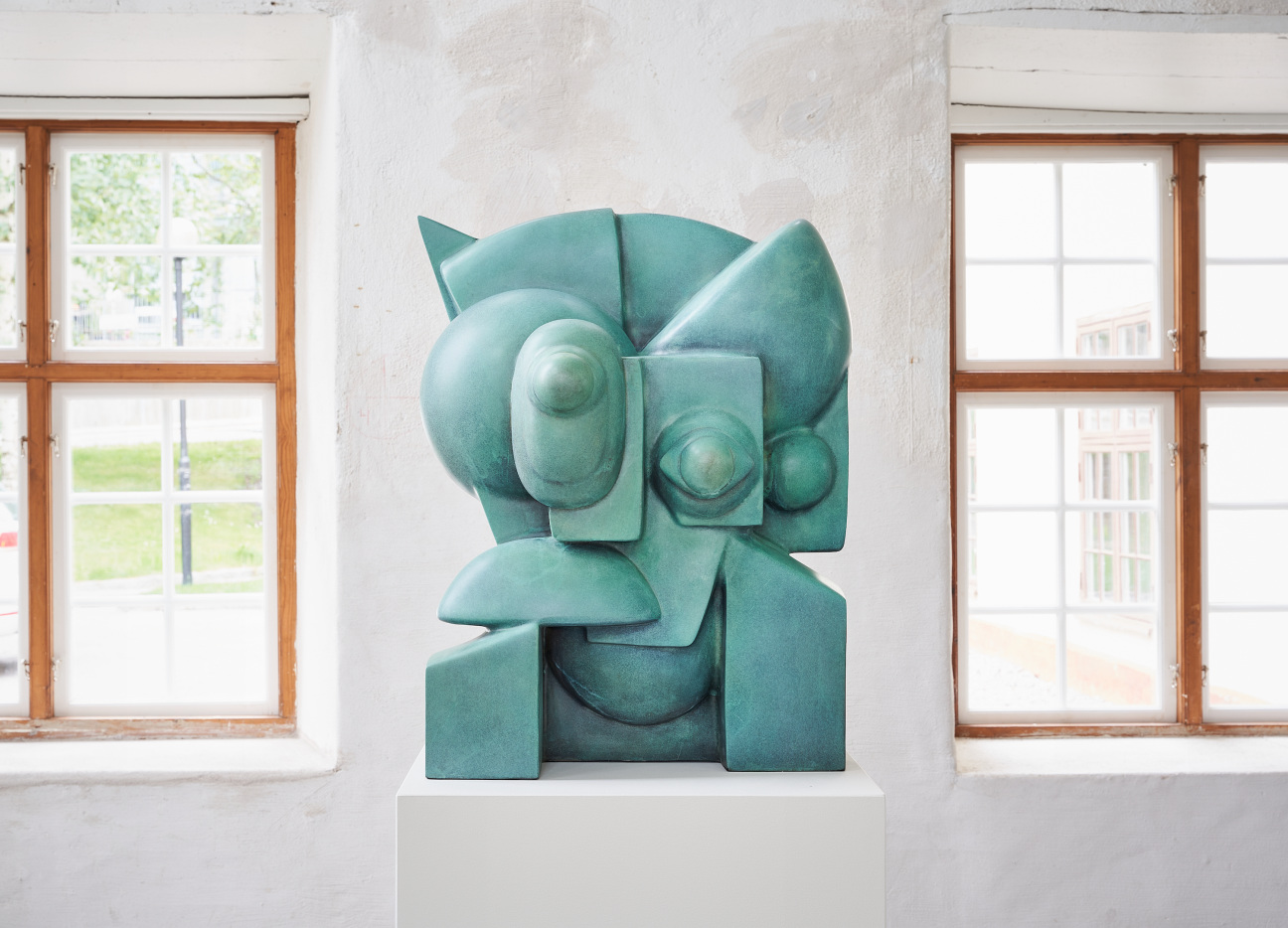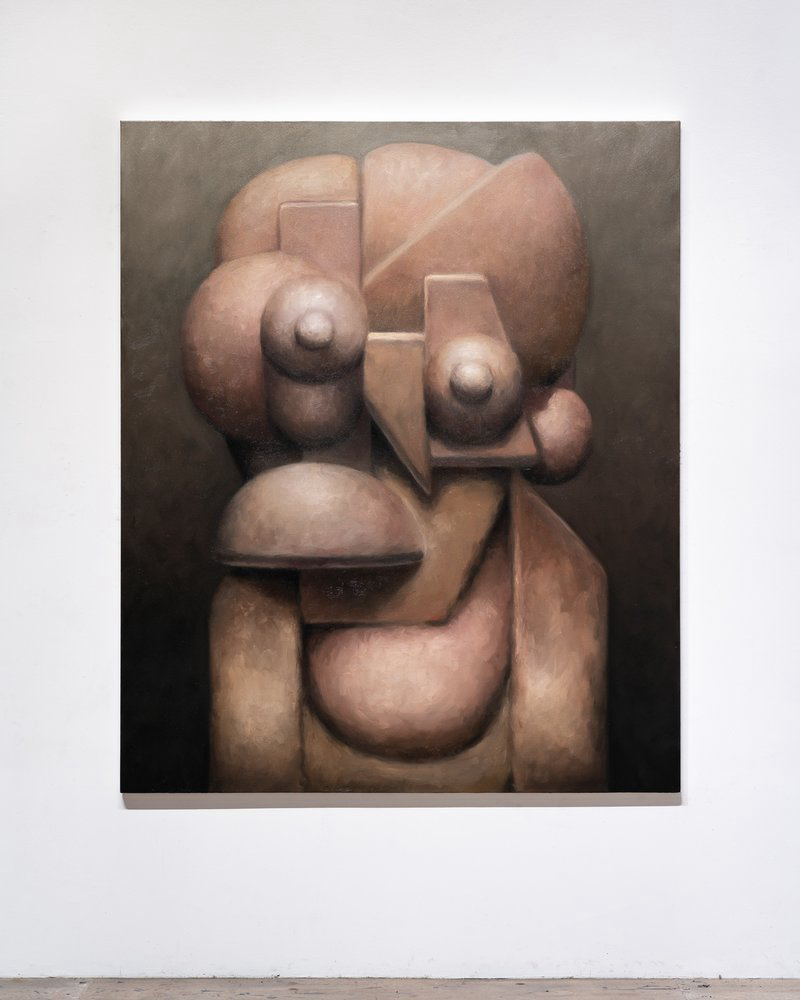
Most people try not to think too hard about the nature of existince. Devon DeJardin is not most people.
Born in Portland, Oregon, the self-taught multimedia artist utilizes geometric shapes to create ambiguous, abstract forms that meditate on the fragility of reality. These almost-figures, which DeJardin refers to as "gaurdians," both have heft and are barely there, somewhere between a rock formation and an animation.
It is this tension that inspires "Pareidolia," his latest and first show with CARL KOSTYÁL on view through July 21 at Hospitalet in Stockholm. Defined as "the tendency to perceive a specific, often meaningful, image in a random or ambiguous visual pattern," pareidolia is a curious phenomenon, one that piqued DeJardin's interest after years of studying spiritual traditions. Pulling from the myths of ancient Greece and the Aztecs and the secrets of the Easter Island heads and Stonehenge, the artist paints and sometimes sculpts these guardians, referencing the past while also crafting their future.
DeJardin sat down with CULTURED to talk about his spirituality, creating a body of work over time, and what this next chapter holds.

By Sol Summers.
CULTURED: You refer to the sculptural formations in your paintings as “guardians” and frequently use them in lieu of traditional figuration. How did you come up with this term, and what does it mean in the context of your work?
Devon DeJardin: The term "guardians" emerged from my exploration of spirituality and the concept of protection. These figures embody watchfulness and resilience, serving as sentinels that safeguard intangible elements like hope and faith. In my work, they replace traditional human forms, symbolizing an abstract yet powerful presence that invites viewers to find their interpretations and connections. The guardians draw from a rich tapestry of spiritual and cultural symbols, evoking a sense of timeless guidance and support.
CULTURED: Your career started in fashion, and then you transitioned into painting. What prompted this shift, and how is your past life in fashion in conversation with your present as an artist?
DeJardin: My transition from fashion to painting was prompted by a personal journey of discovery and a nudge from an unexpected mentor. While I no longer work in fashion, the structured creativity and attention to detail I developed in that field continue to influence my approach to painting. In both fields, one strives to convey narratives and evoke emotions through aesthetics, blending experiences to create art that feels both familiar and innovative. My career evolution has allowed me to integrate a deep understanding of form, texture, and visual storytelling into my paintings, enriching my artistic expression.

CULTURED: Before formally becoming an artist, you studied world religion for over four years, and you recently spoke with Dr. Aaron Rosen about the influence of spirituality on your work in “Echoes of the Past.” Could you describe your relationship to religion and spirituality?
DeJardin: My relationship with religion and spirituality is deeply intertwined with my artistic practice. Studying world religions provided a broad understanding of different belief systems and their narratives of protection, guidance, and existential inquiry. This knowledge fuels my work, where I integrate spiritual symbols and themes, creating pieces that invite contemplation and dialogue about the unseen forces that shape our lives. It allows me to infuse my art with a sense of the sacred, exploring the universal search for meaning and connection.

Photo by Ahram Park.
CULTURED: “Pareidolia” is your first solo exhibition with CARL KOSTYÁL. What was the biggest challenge going into this show? What aspect of it are you most excited about for people to experience?
DeJardin: The biggest challenge was ensuring that the diverse range of works from the past five years cohesively conveyed the themes of pareidolia and guardianship. I am most excited for people to experience the interplay of light and form in the paintings, which create a sense of timelessness and invite viewers to find their meanings within the abstract figures. This exhibition allows viewers to immerse themselves in the mystical world of the guardians, engaging with the themes of protection, spirituality, and the enigmatic nature of the human experience.
CULTURED: This show contains work spanning the past five years. What kind of evolution did you see in your artistic process over these years? Do you feel any connection between the spirituality and mysticism in the paintings and the patience with which you created them?
DeJardin: Over the past five years, my artistic process has become more refined and intentional. The evolution is marked by a deeper integration of spiritual and mystical elements, reflecting my ongoing exploration of these themes. The patience required in creating these works mirrors the contemplative nature of spirituality, where each layer and detail contributes to a larger, meditative narrative.

CULTURED: Time operates in an interesting way in your work; your figures recall both ancient sculptures and building blocks. Was it your intention to have these figures feel outside of time or in their timeline?
DeJardin: Yes, it was intentional. I wanted the figures to evoke a sense of timelessness, blending ancient forms with modern aesthetics to create a visual dialogue across eras. This timeless quality allows the guardians to exist in their unique timeline, transcending specific historical contexts and connecting with viewers on a universal level. By doing so, the guardians serve as bridges between the past, present, and future, inviting viewers to reflect on the continuity and evolution of human experience.
CULTURED: “Pareidolia” is the tendency to seek meaning from a seemingly ambiguous visual, often discovering the shapes of faces within inanimate objects. How did you arrive at this title?
DeJardin: The title "Pareidolia" captures the essence of my work, where abstract forms invite viewers to find familiar shapes and faces within them. This concept resonates with my intention to create guardians that are simultaneously recognizable and enigmatic, encouraging a deeper engagement with the art and the meanings we project onto it. The idea of pareidolia reflects the human tendency to seek and find patterns, exploring the intersections of perception, imagination, and reality.

Photo by Ahram Park.
CULTURED: As David Risley notes in the press release, your works “are made of themselves. They are simulacra—exact copies of originals that never existed.” There’s almost an uncanny quality to them. Can you speak to this?
DeJardin: The uncanny quality arises from the paradox of creating something that feels both familiar and entirely new. My works are simulacra in that they imitate forms and figures that exist only in the collective imagination. This creates a sense of déjà vu, where viewers recognize elements of the guardians but are also challenged to confront the idea of originality and existence. By blurring the lines between reality and representation, my art explores the depths of perception and the nature of artistic creation.
CULTURED: You occasionally sculpt the “guardians” from your paintings, creating three-dimensional renderings of your subjects. What moves you to not just paint a structure but build it, too?
DeJardin: Sculpting the guardians brings a tangible dimension to the abstract figures, allowing me to explore their presence in physical space. This transition from two-dimensional paintings to three-dimensional sculptures deepens the narrative and provides a new way for viewers to interact with and experience the guardians' protective and contemplative essence.
CULTURED: For this show, you found inspiration in the work of Henry Moore, Barbara Hepworth, and Yves Tanguy. How does engaging in the work of other artists inform your creative process?
DeJardin: Engaging with the work of artists like Moore, Hepworth, and Tanguy enriches my creative process by offering new perspectives on form, space, and abstraction. Their exploration of organic shapes and surreal landscapes resonates with my quest to blend the real with the imagined. These influences help me to create a unique visual language that bridges the gap between tradition and innovation.

Photo by Ahram Park.
CULTURED: What are you most looking forward to about this next chapter in your career?
Dejardin: I am most looking forward to continuing the exploration of guardians and their evolving forms, delving deeper into the spiritual and mystical themes that drive my work. This next chapter promises new collaborations, expanded mediums, and the opportunity to connect with audiences in more profound and varied ways. The journey ahead is one of discovery and growth, and I am excited to see where it leads.










 in your life?
in your life?

